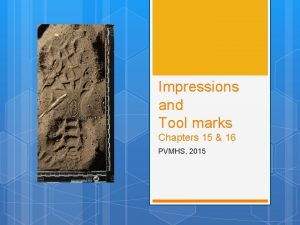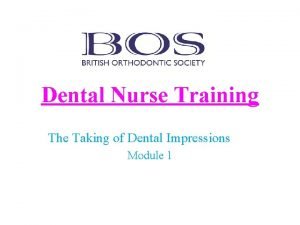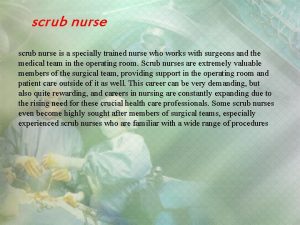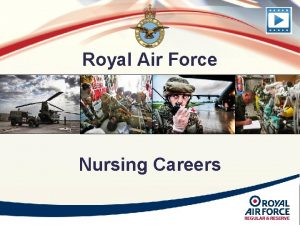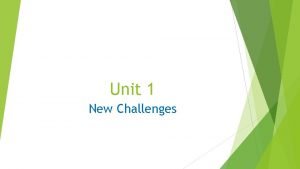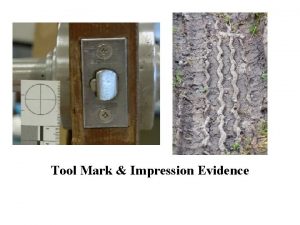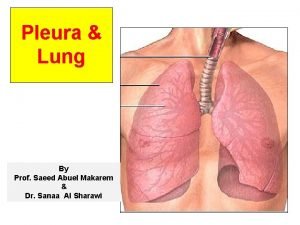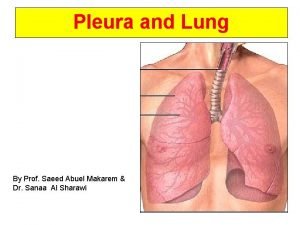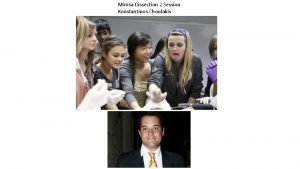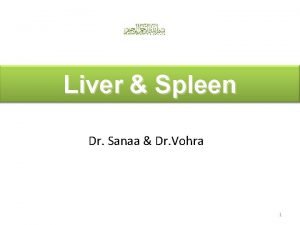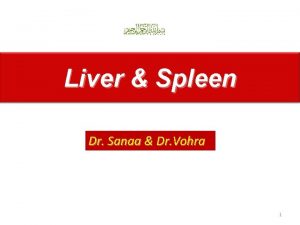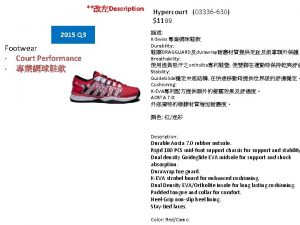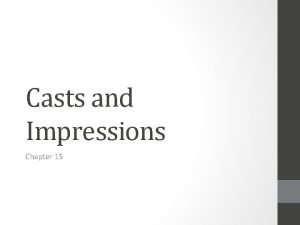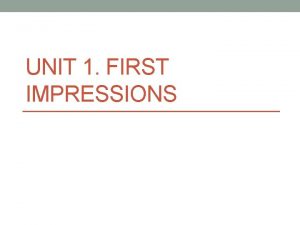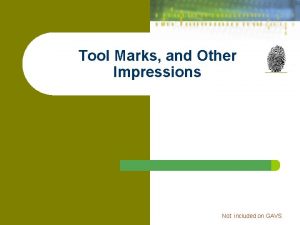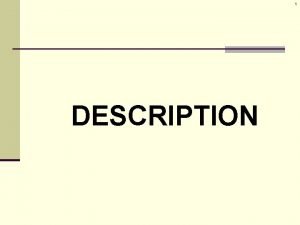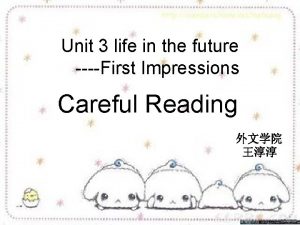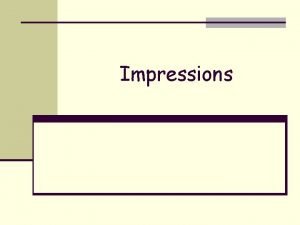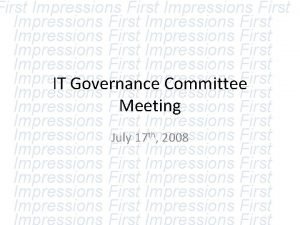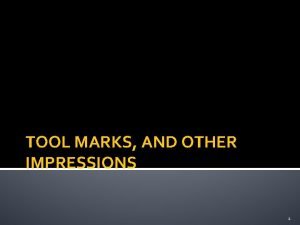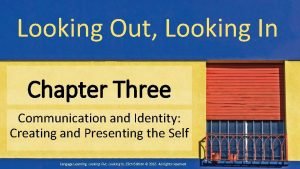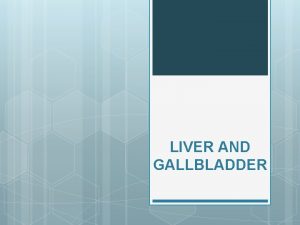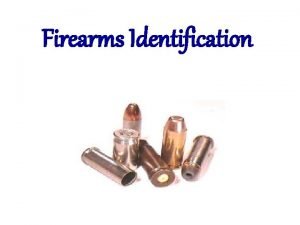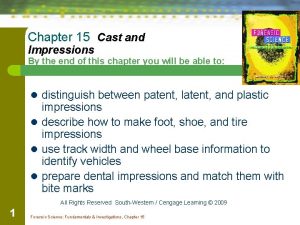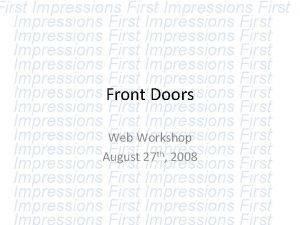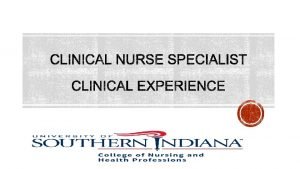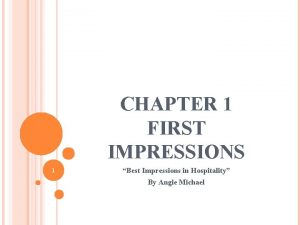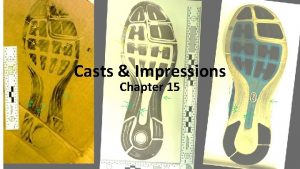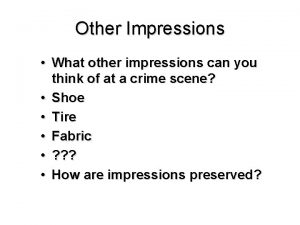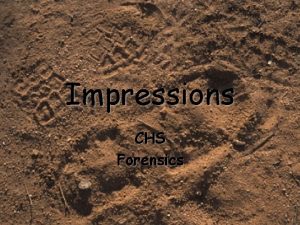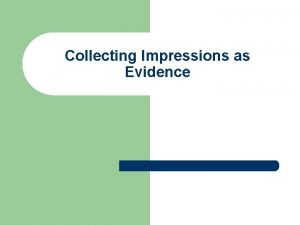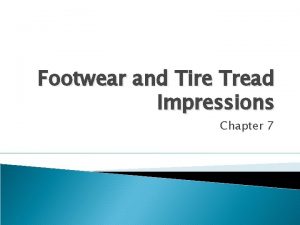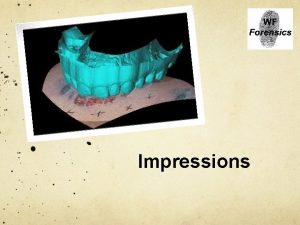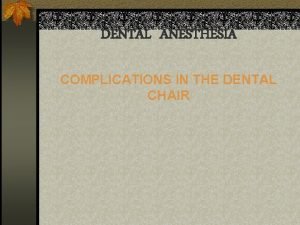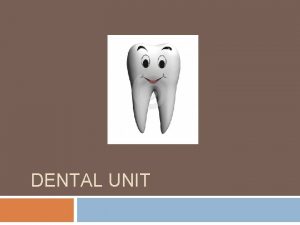Dental Nurse Training The Taking of Dental Impressions





































































- Slides: 69

Dental Nurse Training The Taking of Dental Impressions Module 1

The Taking of Dental Impressions Is A training course set up by the BOS to provide qualified and registered Dental nurses with the knowledge and skills needed to take dental impressions

The Course will provide the student: • with scientific/clinical knowledge and an understanding of the taking of dental impressions. • with the practical skills needed. • with the management of patient care and communication.

The course will provide • Aims and Objectives through lectures and presentations • Demonstration and practical skills • Learning Outcomes

Aims and Objectives Aims • To provide knowledge and understanding required for the taking of impressions within a clinical environment • To provide practical skills required in the taking of impressions within the dental environment • To provide skills in the management of patient care and communication

Objectives • To have the knowledge and understanding required to carry out the taking of impressions within the dental environment • To be competent in the practical skills required in the taking of dental impressions • To be competent in the management of patient care and communication

Once the student is considered competent and a record of experience has been completed and assessed, a certificate of achievement will be issued with 10 verifiable CPD hours

Record of Experience The student will need to complete a record of experience which will need to be assessed by the course provider. The log sheets will contain: • 10 observations of the taking of dental impressions with clinical instruction • 20 supervised taking of dental impressions with clinical support • 20 unsupervised taking of dental impressions with clinical support. Five of these must be taken of an adult

The Syllabus • The provision of scientific/clinical knowledge of the taking of dental impressions • Procedures involved in the taking of dental impressions within a clinical environment • Communication within the dental environment • Legislation and Health and Safety guidelines controlling the taking of dental impressions

Scientific/clinical Knowledge • This will be provided by the Dental clinicians at Mid-Wessex Orthodontics and the supporting Dental Care Professional Team • This will be provided in the form of lectures, presentation and practical demonstration.

Clinical Procedures • • • At the end of this unit the dental nurse will: Be competent in the correct selection of dental biomaterials Be competent in the correct manipulation and safe handling of dental biomaterials Have knowledge and understanding of the science and limitations of dental biomaterials Be competent in the selection of impression trays and be aware of their advantages and disadvantages Be competent in the taking of accurate dental impressions

Communication At the end of this unit the dental nurse will: • Be able to demonstrate excellent communication skills with patients, their families and carers, other members of the dental team and other health care professionals • Be able to demonstrate empathy and manage patients from different social/ethnic background and those with additional needs/special care requirements • Be familiar with the manifestations of anxiety and pain and be able to demonstrate method of management and control

Health and Safety and Legislation • • At the end of this unit the dental nurse will: Be competent in the implementation of excellent infection control, preventing the physical, chemical and microbiological contamination in the clinical area and laboratory (where applicable) Be competent in the correct disinfection of dental impressions Be knowledgeable in the responsibilities of consent Be competent in the implementation of medical emergencies and how to respond to them

Dental Nurse Training The Taking of Dental Impressions Module 2

Scientific Knowledge and Clinical Procedures Dental Impression Materials

Aims and Objectives Aims • To provide scientific knowledge of dental impression materials to enable correct selection of appropriate materials • To provide knowledge to enable the taking of dental impressions Objectives • To have the scientific knowledge for the correct selection of appropriate materials and the ability to take dental impressions

Dental Impressions • Dental impressions are taken of the patients oral structures to form a mould that has negative dimensions • The mould is then cast using a dental gypsum product to form a positive model of the physical dimensions, shapes and spatial relationships of these structures

Materials used for the taking of impressions is mixed (using manufacturers instructions) to form • A preparation in a low viscosity state that is placed and formed against the oral structures • Significant increase in the viscosity of the material occurs • The preparation is then removed from the patient’s mouth Increase in viscosity happens due to physical changes in temperature or a chemical reaction to the properties of the preparation

Changes in the properties of the preparation The combination of the properties before, during and after the setting of the preparation determines the suitability of the impression material for each clinical situation

Dental Impressions There are different types of impression material used in dentistry and are determined by the clinical procedure • Those with minimal elastic deformation after setting • Those that undergo significant elastic deformation required to remove the material after setting.

Dental impression materials • Impression compounds • Elastics- hydrocolloids • Elastics-Silicones/polyethers • Polysulphides

Impression Compounds These are mainly rigid impression materials that set by physical change • Red, green or brown stick compound • Zinc oxide paste with eugenol • Dental gypsum (impression plaster)

Impression Compounds These compounds are still used occasionally in the surgery but are most likely to be used in the dental laboratory. They have poor dimensional stability and are messy to use.

Elastics-Hydrocolloids These dental impression materials are used frequently both in the surgery and the laboratory. There are two types: Reversible hydrocolloid- Agar Irreversible hydrocolloid- Alginate

• Agar- used for duplicating study models and working models usually in the laboratory. The material can be reused. • Alginate- used for study models, orthodontic study models, working models for first stage of prosthesis, orthodontic appliances, corresponding dental arches for crown and bridge work, mouth-guards. This material cannot be reused

Alginate Advantages • Easy to prepare and mix- powder and water, sets by chemical reaction • Easy to manipulate and form around oral structures • Reasonable dimensional stability • Economic Disadvantages • Can shrink and distort if not submerged in disinfection solution before casting • Can absorb solution if left submerged for too long causing it to distort • Can tear easily • It is not suitable for more complex and detailed dental work such as crown and bridge work, chrome cobalt partial dentures and some orthodontic appliances (Invisalign, lingual fixed appliance)

Alginate Powder Consists of • Potassium alginate or sodium alginate and calcium hydrate – they react together to form calcium alginate gel which is insoluble in water. • Sodium alginate is derived from seaweed • The material is viscoelastic and is the principal component of the impression material • It also contains a substantial amount of filler, disinfectant, setting time modifiers and chemicals to counteract the inhibiting effects of the material on contact with dental gypsum • It also contains glycol which prevents the small powder particles from being inhaled during dispensing

Preparation, mixing and handling of alginate As registered and qualified dental nurses you are aware of the correct procedures in the preparation, mixing and handling of alginate and this will be revised during the practical demonstrations

Characteristics of alginate • There is little dimensional change during setting • There is optimal resistance to plastic deformation when removing from the patients mouth • However, it can tear when removing if there are obstacles such as the presence of fixed orthodontic appliance, failing restorations, undercuts or the presence of a fixed or removable prosthesis

Properties of Alginate After setting, water is easily exchanged into or out of the gel which can affect dimensional accuracy, therefore casting as soon as possible is advised. If left to dry out, it will shrink and if left in disinfectant solution for too long it will absorb water and distort

Elastics-Polyethers and silicones are: Rubber like synthetic material formed by chemical reaction Polysulphides are not often used and so will not be discussed further on this course

Polyethers and silicones These impression materials require a: • Base • Catalyst Equal parts of these are mixed thoroughly together. They are manipulated and formed around the oral structures, a chemical reaction takes place and the preparation sets.

Polyethers and silicones These preparations have different properties and can be • Light body- used as a ‘wash’ for fine detailing for crowns, bridges, inlays, veneers, invisalign • Medium body- can be used for relining dentures, chrome cobalt partial dentures • Heavy body- used for the negative mould of the oral structures and a carrier for the light/medium body elastics/elastomers

Polyethers and silicones Advantages • Excellent dimensional stability • Good detailing • Easy to mix and manipulate • Does not tear Disadvantages • Expensive • Cannot be mixed using latex gloves (nitrile gloves are recommended)

The Taking of Dental impressions The instruction of the taking of dental impressions is a practical lesson and will be carried out in the surgery. Alginate impression material will be used for the practical. Information sheets will be available at this session.

Dental Nurse Training The Taking of Dental Impressions Module 3

Communication

Aims and Objectives Aims • To provide knowledge to enable excellent communication skills with patients, their families and carers, other members of the dental team and other health care professionals • To provide knowledge to enable empathy and manage patients from different social/ethnic background and those with additional needs/special care requirements • To provide knowledge to manage the manifestations of patient anxiety and pain and to demonstrate method of management and control

Objectives • To have the knowledge to enable excellent communication skills with patients, their families and carers, other members of the dental team and other health care professionals • To have the knowledge to enable empathy and manage patients from different social/ethnic background and those with additional needs/special care requirements • To have the knowledge to manage the manifestations of patient anxiety and pain and to demonstrate method of management and control

Communication It is always important to consider the patient, their accompanying family members and carers. As a DCP always • Be polite and courteous • Use positive reinforcement in your language and refrain from using dental ‘jargon’ • Use positive and open body language • Explain the procedure • Gain consent

What is effective Communication?

The ability : • To use active listening skills • To have open body language • To gather and impart information effectively • To handle patient’s emotions sensitively • To demonstrate, empathy, rapport, social and ethical awareness • To be professional

Benefits: • Increased patient satisfaction • Decreased patient anxiety • Improved patient co-operation to dental recommendations • Lower rates of formal complaints and malpractice claims

In 1990, the inclusion of teaching behavioural science in dental schools was published in the General Dental Council guidelines

It was recommended that communication skills were taught to include: • Interpersonal skills • Practical based learning such as role play and clinical relevant scenarios • Self assessment and evaluation • Small groups for optimal learning

The Calgary-Cambridge Concept (CCOG) is • An evidence based approach to cover the content and serve as an organisational guideline • Recommended as being one of the most comprehensive and useful frameworks for instruction of communicational skills • It is judged as the communication guideline of the highest quality • It integrates the social and technical processes typical in the dental world

The Calgary-Cambridge Concept (CCOG) covers many aspects that you as qualified and registered Dental nurses have been trained in and are aware of such as • Introduction • Explanation, procedure, importance of consent • Body language, facial expressions, emotion • Listening skills

Communication Consent It is always important to gain consent before continuing with any procedure • Implied consent- the patient gives consent by sitting in the dental chair and opens their mouth • Informed consent- the procedure is explained and the patient verbally consents to proceed • Written consent- the patient or their parent/guardian reads a document with the procedure clearly explained and signs to confirm they are happy to continue

Communication Anxiety Control

Aims • To become familiar in the manifestations of anxiety and the various methods of management and control • To develop theoretical, practical and clinical skills to manage fear and anxiety using behaviour techniques and empathy with patients in stressful situations Objectives • Be familiar with the manifestations of anxiety and the various methods of management and control • Be competent in the management of fear and anxiety using behavioural techniques and empathy to support patients in stressful situations

The Management of anxiety As DCPs, we have a duty of care to provide. Our patients expect adequate anxiety and pain control Maintaining Standards (GDC 2001)

Management of Anxiety • Fear is a well recognised reason for avoiding dental care. • Dental anxiety can affect 1/3 of the UK population • The anxiety may be specific to an aspect of treatment such as injections, extractions, dental impressions • Fear and anxiety manifest itself in many different ways such as agitation, fidgeting, swallowing, crying, aggression, excessive talking, perspiring • Anxiety is a learnt response and can also be learnt vicariously. • Fear and anxiety can be based on past distress

Management of anxiety Phobia • • • An irrational fear The fear is disproportionate and excessive to the threat The stimulus is relatively small The abnormal fear is deeply imbedded in the patient’s pysche There is no control over the phobia There is no logic The phobia can drastically change the patient’s behaviour Often, the patient is embarrassed or ashamed of their irrational fear 10% of the UK population have a dental phobia

Management of anxiety As with signs of anxiety, the dental phobic may • Be hyper-vigilant • Be breathless, tachycardia or be hyperventilating • Palpitations, hypertensive • Feel faint, nauseous or have stomach cramps • Develop a tremor • Dry mouth • Diuresis All these signs and symptoms can also effect the patient’s wellbeing and be part of another underlying issue or problem. Management here can be paramount.

As DCPs, we are all aware of how anxious patients can be. Being able to communicate effectively with the patient and their accompanying family or carers can help to alleviate distress, allay fears, which in turn can gain trust and co-operation. Each situation will be different, be prepared to diffuse the situation, stay calm, be patient, be supportive, be polite, stay professional.

Laboratory Communication Whether you have an ‘in house’ laboratory or work is sent out of the practice, verbal and written communication is vital • To prevent mistakes • To track each item • To ensure all items are correctly disinfected (this will be covered in infection control in unit 4) • To ensure each item is correctly labelled with name of practice and of the patient, date taken and disinfected and by whom, clear instruction, date and time the work needs to be returned

Laboratory Communication Surgery to laboratory • All work must be accurately documented • All work must have patient name and/or ID number • All work must have details of dental practice, name of clinician, practice ID number • Record of disinfection, date and by whom • Date sent • Note of what has been sent • Record of item/items requested • Date and time required to be returned

Laboratory Communication Laboratory to surgery • Laboratory ticket to accompany all work • Computer check in and out system for all work (This makes it easy to check work is ready or has been returned and is in the surgery prior to the patient’s appointment) • Individual signatures on receipt of work to track its journey • This helps reduce errors • Good communication and relationship with the laboratory adds to the smooth running of the practice

Dental Nurse Training The Taking of Dental Impressions Module 4

Legislation and Health and Safety

Legislation Guidelines controlling the taking of dental impressions • Consent • Duty of care (including Medical Emergencies) • Confidentiality

Consent • Inform patient, patient’s parents/legal guardian/carer of treatment plan • Information must be valid • Obtain informed consent

Duty of Care • To every patient • Includes the handling of medical Emergencies • Complaints handling- initially within the practice

Medical Emergencies • • It is important that you have knowledge of Contents of the first aid box and where it is kept Basic life support Normal parameters of pulse rate- use of oximeter Normal body temperature- use of oximeter

Medical Emergencies It is important to know the signs, symptoms and action taken for emergencies such as • Fainting (syncope) • Angina • Heart Attack (cardiac arrest) • Anaphylaxis • Epilepsy • Asthma Attack • Diabetic hypo/hyperglycaemia

Medical Emergencies When taking dental impressions the most likely emergency is the patient choking either by inhaling impression material or a dislodged tooth or failing dental restoration. • Sit the patient upright and encourage them to cough If a tooth or debris has been dislodged • Check surrounding area to locate and inform the patient • The object may have been swallowed or inhaled • If inhalation is suspected, as a precaution arrange for chest radiograph at local hospital • Accompany patient if necessary and ensure letter is written explaining history • Always record event accurately in clinical notes with time, date, those present

Confidentiality • Data protection Act covers the confidentiality of patient notes • In some circumstances, patient records can be released to the Business Services Agency or the police

Infection Control The Taking of Dental Impressions As qualified and registered Dental Nurses, you have already been highly trained in the disinfection of dental impressions, dental appliances and medical devices which is covered in the HTM 01 05 (Section 2, -7. Impressions, prostheses and orthodontic appliances) This will be revised in the practical sessions

At the end of your course please ensure that you complete the feedback form. ADD practice details for feedback submission.
 Indentation tool marks
Indentation tool marks Dental impressions courses
Dental impressions courses Responsibility of scrub nurse
Responsibility of scrub nurse Nurse logic ati
Nurse logic ati Dental charting abbreviations
Dental charting abbreviations Royal air force nurse
Royal air force nurse Unit 1 first impressions
Unit 1 first impressions Tool mark impressions
Tool mark impressions Example of dominant impression
Example of dominant impression Ma vision du métier observé
Ma vision du métier observé Where is the apex of the lungs located
Where is the apex of the lungs located Lung lobe
Lung lobe Anterior thorax
Anterior thorax Portacaval anastomosis
Portacaval anastomosis Splenic ligaments
Splenic ligaments Chapter 15 firearms toolmarks and impressions
Chapter 15 firearms toolmarks and impressions Chapter 15 firearms toolmarks and impressions
Chapter 15 firearms toolmarks and impressions Class characteristics of footwear impressions
Class characteristics of footwear impressions Types of tire marks
Types of tire marks Mes impressions sur le stage exemple
Mes impressions sur le stage exemple First impressions examples
First impressions examples Abrasion marks are made by objects which include
Abrasion marks are made by objects which include Harmonize impressions with positive cues
Harmonize impressions with positive cues How to write first impression
How to write first impression True or false
True or false Forensic factor lasting impressions
Forensic factor lasting impressions What is a literacy narrative example
What is a literacy narrative example Arch
Arch Are impressions left by friction ridge skin on a surface
Are impressions left by friction ridge skin on a surface First impression test
First impression test First impressions of beowulf
First impressions of beowulf What are your first impressions of beowulf
What are your first impressions of beowulf Examples of dominant impressions
Examples of dominant impressions First impressions count reading answers
First impressions count reading answers Reading impressions
Reading impressions Tools marks
Tools marks First impressions finger print
First impressions finger print Landlady roald dahl
Landlady roald dahl Evidence of evolution of remnants and impressions *
Evidence of evolution of remnants and impressions * Convert impressions to grps
Convert impressions to grps Patent impressions
Patent impressions Francis bacon paintings organum
Francis bacon paintings organum First impressions
First impressions Academic impressions
Academic impressions First impressions four marks
First impressions four marks Partial varia breast shapers
Partial varia breast shapers Breadth of penetration
Breadth of penetration Omental tuberosity
Omental tuberosity Forensic tire tread analysis
Forensic tire tread analysis First impressions count job interview
First impressions count job interview 3 ring bullet identification
3 ring bullet identification There are two basic types of impressions patent and latent
There are two basic types of impressions patent and latent Hình ảnh bộ gõ cơ thể búng tay
Hình ảnh bộ gõ cơ thể búng tay Frameset trong html5
Frameset trong html5 Bổ thể
Bổ thể Tỉ lệ cơ thể trẻ em
Tỉ lệ cơ thể trẻ em Voi kéo gỗ như thế nào
Voi kéo gỗ như thế nào Chụp phim tư thế worms-breton
Chụp phim tư thế worms-breton Chúa yêu trần thế
Chúa yêu trần thế Môn thể thao bắt đầu bằng chữ đua
Môn thể thao bắt đầu bằng chữ đua Thế nào là hệ số cao nhất
Thế nào là hệ số cao nhất Các châu lục và đại dương trên thế giới
Các châu lục và đại dương trên thế giới Công thức tính thế năng
Công thức tính thế năng Trời xanh đây là của chúng ta thể thơ
Trời xanh đây là của chúng ta thể thơ Mật thư anh em như thể tay chân
Mật thư anh em như thể tay chân 101012 bằng
101012 bằng Phản ứng thế ankan
Phản ứng thế ankan Các châu lục và đại dương trên thế giới
Các châu lục và đại dương trên thế giới Thơ thất ngôn tứ tuyệt đường luật
Thơ thất ngôn tứ tuyệt đường luật Quá trình desamine hóa có thể tạo ra
Quá trình desamine hóa có thể tạo ra
